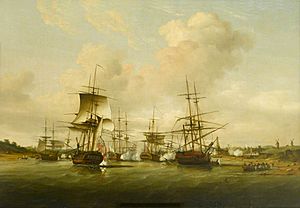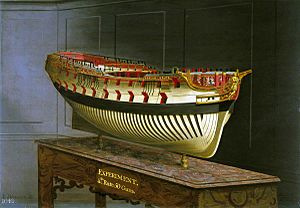Action of 13 May 1779 facts for kids
Quick facts for kids Action of 13 May 1779 |
|||||||
|---|---|---|---|---|---|---|---|
| Part of the American Revolutionary War | |||||||
 Action off the Coast of France, by Thomas Luny |
|||||||
|
|||||||
| Belligerents | |||||||
| Commanders and leaders | |||||||
| Strength | |||||||
| 3 frigates 1 sloop 1 brig |
2 frigates 1 gabarre 2 sloops 1 brig 1 cutter 1 shore battery |
||||||
| Casualties and losses | |||||||
| 2 killed 15 wounded |
1 frigate captured 2 merchantmen captured 1 gabarre burnt 1 brig destroyed 1 sloop destroyed 1 cutter scuttled 1 shore battery damaged |
||||||
The Action of 13 May 1779 was a naval battle during the American Revolutionary War. It took place in Cancale Bay, near St Malo, France. This fight was between a group of French warships and a British squadron. The British ships were led by Captain Sir James Wallace. The French ships were part of a force that had tried to invade Jersey.
The French invasion of Jersey had failed earlier in May. Their ships retreated to a place called Coutances. The British gathered a large group of ships to attack them. They planned a special two-part attack. The British chased the French ships up the coast. The battle ended with a British victory.
Contents
Background to the Battle
On May 1, 1779, French forces tried to invade the island of Jersey. Their goal was to capture the island quickly. This invasion force included five large warships and many smaller ones. They also carried 2,500 soldiers. The French tried to land at Saint Ouen Bay.
However, local soldiers and the 78th Regiment of Foot stopped their attack. The French could not land their troops. So, they had to sail away from Jersey. The island's governor sent a fast boat to get help. This boat met a British fleet led by Rear-Admiral Mariot Arbuthnot.
Arbuthnot's fleet was heading to North America. But he changed course to help Jersey. He arrived on May 4, but the French invasion force had already left. Meanwhile, the messenger boat reached Portsmouth, England. Admiral Sir Thomas Pye sent more British ships to Jersey.
These ships were led by Captain John Gidoin. Captain Sir James Wallace was also in the area. He had been left behind by Arbuthnot to help protect Jersey. Gidoin's ships joined Wallace's ships at Boule Bay.
The Fight in Cancale Bay
On May 10, the leader of Jersey sent a message to Captain Gidoin. He reported that French ships were seen near the Chausey islands. These French ships had been helping with the failed invasion. Captain Wallace decided to stay and help Gidoin.
Small British ships were sent to check on the French ships. They found the French force anchored near Coutances. The French group included two frigates, a supply ship called a gabarre, a small warship called a corvette, and a fast boat called a cutter.
Gidoin and Wallace decided to split their forces. They wanted to trap the French ships. Wallace took his ship, Experiment, and several others. Gidoin took his ship, Richmond, and the rest of the squadron. They sailed on May 12. Gidoin went straight for Coutances. Wallace sailed around Jersey to block any escape route.
When Gidoin's ships appeared, the French ships sailed north. They were heading towards St Malo. They didn't know that Wallace was waiting for them there. Gidoin chased the French, but the tide was against him. He had to stop and anchor his ships. Wallace's ships also faced difficulties but managed to get around Jersey.
On May 13, Gidoin's ships started sailing again. At 10 a.m., he saw Wallace's squadron. Wallace was chasing the French ships. The French had anchored in Cancale Bay. Gidoin could not catch up. So, he did not take part in the main battle.
Early that morning, Wallace found another French frigate. This ship was sailing from St Malo to help the other French ships. Wallace chased this new ship. It went under the protection of the shore batteries at St Malo. Wallace could not attack it there. So, he turned his attention back to the original French group. They were just outside Cancale Bay.
The British Attack
The French ships sailed into Cancale Bay to escape. But Wallace, leading in Experiment, followed them. Seeing this, the French crews ran their ships aground. They hoped to save them from being captured or destroyed. The rest of Wallace's ships caught up. They began firing on the beached French vessels.
The firing lasted for an hour and a half. The French crews were forced to leave their ships. They escaped to safety on land. The French ships were now at Wallace's mercy. However, his attack caused the local French soldiers to gather. They brought cannons and fired at the British ships.
Being under fire in a closed bay was dangerous. Wallace could not take all the French ships as prizes. Instead, he ordered two of the three frigates to be burned. He also ordered the cutter Dieppe to be sunk. But the third frigate, Danae, was successfully captured. Two merchant ships, a brig, and a sloop were also taken.
While the British were dealing with the French warships, a French shore battery began firing. This battery had six powerful cannons. It was manned by the crews of the deserted French ships. The battery fired heavily on Experiment. Wallace was very annoyed by this. After Danae was secured, he took control of her.
He sailed Danae up the bay to attack the battery. After forty-five minutes, he destroyed the battery. The French crews there were forced to leave. The British then sailed out of the bay with their captured ships. These ships were sent to England.
For the British, the battle caused only minor damage and few injuries. Experiment was badly hit in its hull and sails. It lost two men killed and thirteen wounded. The only other injuries were on the ship Cabot. Three men were wounded, and one lost his leg.
The French Side of the Story
The French ship Danae had ten men killed and 20 wounded. Her crew then ran her aground and left her. This happened even though their commander had not given the order. When other French crews saw Danae's crew leave, they also abandoned their ships. The French commander could not set fire to Danae. He had been unable to remove the sick and wounded from the ship.
Aftermath of the Action
The British ship Pallas brought the captured Danae to Plymouth, England, on May 17. The Royal Navy decided to use Danae in their own fleet. She kept the same name. As a reward for their success, several British officers were promoted.
Commander Charles Powell Hamilton and Commander Edmund Dod became post-captains. Lieutenant John Wallace was promoted to commander. The ship Experiment later rejoined Arbuthnot's fleet. They then sailed to New York.
Some of the French ships burned by the British were completely destroyed. However, the French managed to save Guepe after Wallace left the bay. They also later recovered Ecluse.
The loss of their ships forced the French to change their plans. They had wanted to capture Jersey to use it as a base for privateers. But they no longer had enough ships to protect an invasion force. The French tried to invade Jersey again in 1781. But British forces on the island stopped them at the Battle of Jersey.
See Also
- American Revolutionary War
- Invasion of Jersey (1779)
Images for kids
-
Action off the Coast of France, by Thomas Luny



